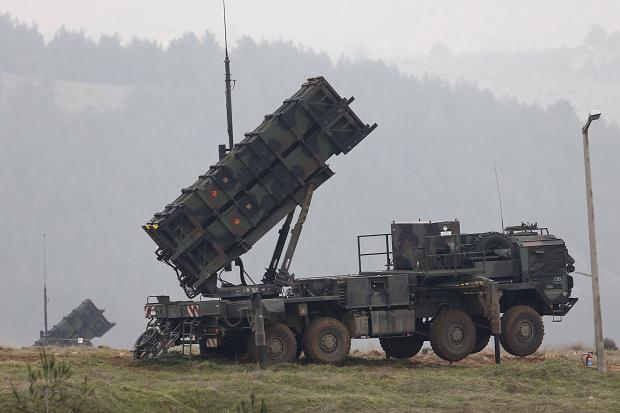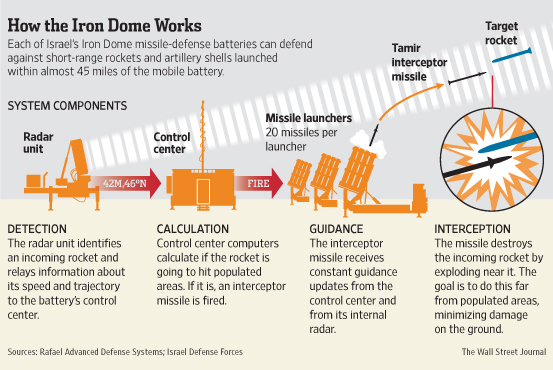July 14, 2014 – In the latest Middle East flare up between Israel and its neighbors, the country has been subject to a barrage of short and long-range missiles. These rockets are launched seconds away from the Gaza-Israel border and at their furthest have a range of 150 kilometers (93 miles). It doesn’t take very long to reach an intended target when you are talking about such short distances. And with such a small window of opportunity an anti-missile defense shield has a mere few seconds to target a missile from its launch point to apogee to descent.
So how can Israel’s Iron Dome anti-missile defense system hope to knock down even one of these rockets? Developed by Rafael Advanced Defense Systems in 2011, Iron Dome uses advanced radar detection, a computerized control system and a launcher containing a battery of 20 Tamir missiles with proximity warheads. Each Tamir has a range of 69 kilometers (43 miles). How quickly does the Iron Dome system pick up a missile launch? As fast as the time it took for you to read this and the last sentence.
Once the incoming missile trajectory and target is known Iron Dome can fire. In some reports Israel has claimed a 90% interception rate. But when you look at the actual number of intercepts per missile launches that number doesn’t hold up. Interception rates are closer to 20% when you consider the total number of missiles fired by Hamas and others in the Gaza Strip. Hidden in that statistic is the fact that Iron Dome doesn’t always launch an intercept. If the trajectory indicates the missile will land in an unpopulated area the battery remains silent. So that 20% interception rate is also too high. And even when the proximity warhead detonates, unless it hits the incoming missile head on, the explosive charge is not destroyed.
My guess, therefore, is that Iron Dome’s numbers are far more likely closer to a 10% success rate. When you consider the physics involved 10% is not too bad. But if Israel were facing longer-range or intercontinental ballistic missiles (ICBMs) coming from farther away, at higher trajectory and much faster speeds, Iron Dome would be ineffectual as a defensive shield.
That’s what’s wrong with anti-missile defense systems. They really don’t work much better than the anti-aircraft artillery and flak discharged by guns in the Second World War to defend cities and industries from bomber attacks. Although both the British, Germans and Japanese developed a wide range of technologies and measures to defend against fleets of bombers, the number of planes destroyed and the lives lost doesn’t compare to the immense devastation and deaths on the ground that these air fleets caused.
So why does the United States invest so heavily in missile defense systems? There are three projects on the go today and the U.S. is also investing in Israel’s Iron Dome. All that money and research to-date has yielded limited success in intercepting known targets. The claim so far is 50% success or better for these current anti-missile systems. But that is based on highly scripted scenarios in which dummy warheads fly the same trajectory every time at lower speeds and altitudes than typical ICBMs. So if you already know where it is coming from and where it is going shouldn’t you do better than 50%?
Well, there’s a reason for that 50%. Shooting down an ICBM is very difficult. They travel at speeds of 24,000 kilometers (close to 15,000 miles) per hour. They are coming from distances many thousands of kilometers away. At the most they are in flight from launch to detonation all of 25 minutes. Many carry multiple warheads which when released are programmed to hit different targets. They are easiest to hit during the launch phase when far away. It can take up to 5 minutes before an ICBM gets up to full speed. But once in mid-flight they are virtually invulnerable to intercept. And upon descent, even if hit, with warheads, already armed, the game is over.
Right now, despite some glowing reports on American Defense sites, the Patriot (seen below) and Aegis missile, and laser weapon systems currently under development have yet to show they can do the job against anything traveling at the speed of an ICBM in full flight. What they can do at best is duplicate Iron Dome’s type of statistics. A lot more miss than hit. Where these systems are effective is in intercepting lower-speed targets such as occurred today when a Patriot missile fired by Israel knocked down a drone launched from the Gaza Strip.
So what can we expect in anti-missile defense in the future? More of the same. Lots of money chasing an elusive target with a less than satisfactory end result.















Len, if this were baseball, you would be confusing balls with strikes. Iron Dome productivity may be defined as 100% less the percent of successful Hamas missile strikes over total Iron Dome launches in a period.
If you want to guesstimate the cost – benefits, we would have to start with the rockets expended vs. projected rocket strike ‘zones’.